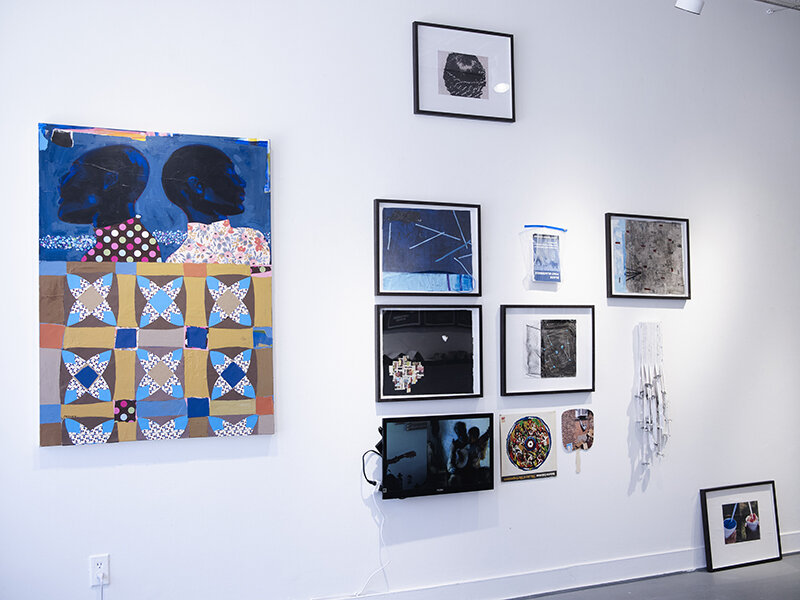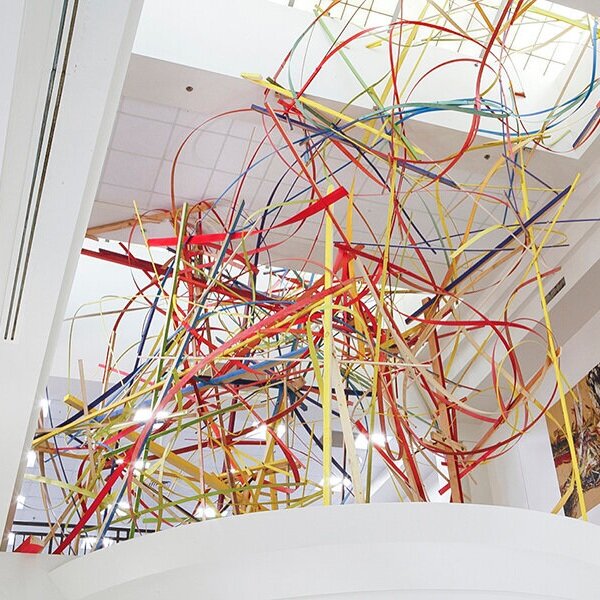Review | Legacy & Rupture
Review | Legacy & Rupture
City Gallery
May 1 - 30, 2021
Installation view of Legacy and Rupture, May 2021. City Gallery. Photo: J. Gleisner.
From the center of the gallery, colorful bundles protrude from a brown backdrop that has been suspended from the ceiling. The intricately wrapped forms punctuating the armature of Sika Foyer’s Trickster point in different directions, while a small stack rests on the floor in front. Drawing from her childhood in Togo, West Africa, Foyer explains on her website that “The wrapping in my artwork and studio practice is an exaggeration of a cross-cultural signifier: how we manifest our care, support and love, and how we heal our communities and ourselves.”
This manifestation of care is one example of the many unexpected departures from traditional artmaking practices that runs through the group show, Legacy and Rupture, on view at City Gallery through the end of this month. Curated by multi-disciplinary artist Howard el-Yasin, the exhibition collects the works of seven contemporary Black artists — the first show of exclusively Black artists at this venue. Their works are centered on the “everydayness of precarity, trauma, and memories” [1] as a means to examine the multiplicity of experiences related to Blackness.
Over the phone, el-Yasin shared, “The invitation to curate a show came on the heels of the cultural awareness of Black Lives Matter. I have been thinking about Blackness in my work for the last year and a half, and this was an opportunity to expand that thinking outside of myself. I learned from this process how to begin to think differently or more broadly about Blackness as a subject matter” [2]. He hopes that viewers will leave this show with different ideas of what it means to be Black, too.
As el-Yasin began the process of selecting works for this exhibition, he approached artists with a short passage by Christina Sharpe, a scholar of Black Diaspora studies. In In the Wake: On Blackness and Being, Sharpe writes, “The past that is not past reappears, always, to rupture the present.” Sharpe’s text analyzes the ways that artists have represented and reflected the ubiquity of antiblackness in our culture.
el-Yasin extrapolates from this and inverts Sharpe’s agenda by anchoring his exhibition to the idiosyncrasies and individual expressions of Blackness. This emphasis on the individual brings pathos to complex conversations about race.
As with Foyer’s Trickster, care can be a meaningful form of disruption, and near the entrance to the small gallery, a mid-sized painting by Ransome depicts a moment of repose. The heads of two Black men face opposite directions under a patchwork quilt reminiscent of those made at Gee’s Bend. el-Yasin explained that the painting was based on a novel, and it depicts two enslaved people who were lovers.
Installation view of Legacy and Rupture. Ransome’s Coming Out (left) and Nathaniel Donnett’s installation In a subtle but noticeable change, the pattern is transposed a step- higher (right). Credit: M. Goma
This personal detail digs into narratives that are often left out: Ransome’s Coming Out reminds viewers how the nation’s history of enslavement is often painted with a broad brush, with specific and individual moments of tenderness withheld from the story. “This painting is about the legacy of same-sex love within the possibilities of Blackness, in spite of slavery, and that the artist is courageous enough to begin a conversation that we should all be having today,” said el-Yasin.
Next to Ransome’s painting, a series of arrows by James (“Ari”) Montford pierce the gallery walls. As an artist of Indigenous and African American heritage, Montford uses the arrows to represent a more literal form of rupture, a physical assault on the white walls of the gallery. The arrows, with their beaded embellishments and brightly colored feathers, have roots in craft traditions — another type of affront on the variety of work displayed in traditional art spaces.
Tellingly, Montford’s work titled Indigenous Trauma, does not have one central location; the arrows jut from the walls in another spot within the gallery. Likewise, traumas reappear, and Montford’s work binds two parallel histories of disenfranchisement.
Throughout the gallery, sounds from Nathaniel Donnett’s video within the artist’s installation enhance the repetitive rhythm of this exhibition. Ideas and visual cues reverberate in this intimate space. From the entrance, Montford’s wrapped arrows peek out from behind similar elements that are present in Foyer’s Trickster. The aesthetic and conceptual ties among these two works opens the possibility that perhaps Foyer’s incarnation of this literary trope was the perpetrator of the sprayed arrows.
Providing an unexpected counterweight to the conceptual gravitas of this show, decoration abounds. The vibrant burst of flowers in Kamar Thomas’s Veil overlooks the patterned quilt in Ransome’s painting. Saturated colors and sounds fill the small gallery.
In another corner, Merik Goma taps into another form of magical realism. Goma has re-created the stage that appears in his photograph, Your absence is my monument, untitled 5, in an installation of a dilapidated bedroom with a mattress and pages tacked to the wall. Standing in this installation, a viewer swaps places with the person in the photograph.
Marissa Williamson, Monuments to Escape installation. City Gallery, May 2021. Image courtesy Howard el-Yasin.
Elsewhere, the topic of monuments resurfaces in Marisa Williamson’s public art project. Williamson mines the evolving relationship of location, history, and artifacts in a visionary and pointed series of postcards and posters called Monuments to Escape. With the text spread out over the ersatz travel posters, Williamson poses questions such as “What narratives have been created around the land which you occupy?” and “What ancestors loom around the structures you find yourself permeating?” She takes aim at the lingering traces of erasure and imperialism along the New England National Scenic Trail. She envisions and inserts her own versions of monuments and historic markers into her images. Williamson, alongside her collaborators, argues for a cultural reckoning that veers into an Afro-Futurist ideology.
Echoing the theme of disruption, Legacy and Rupture offers significant changes from City Gallery’s usual programming. In addition to the exclusively Black roster of artists, this show is the first to include video art. el-Yasin intentionally selected new media and emerging artists as a way to include and attract more of the community.
Legacy and Rupture makes space for conversations about race. The show encourages more fluid thinking in a more general sense, too. “One needs to see things from outside a certain perspective. We need to recognize how all these things — one’s race, gender expression, sexual orientation, religious beliefs, political leanings — are connected,” el-Yasin said. “We need to embrace the right to self-determination. Through that lens, I think we can create a better world for all of us.”
[1] Curatorial statement, Legacy and Rupture. May 2021.
[2] All quotes are from a conversation with the author on May 17, 2021.
Legacy and Rupture continues at City Gallery in New Haven through May 30. Read the Curatorial Essay by Jaime Ernestina Ransome here.






